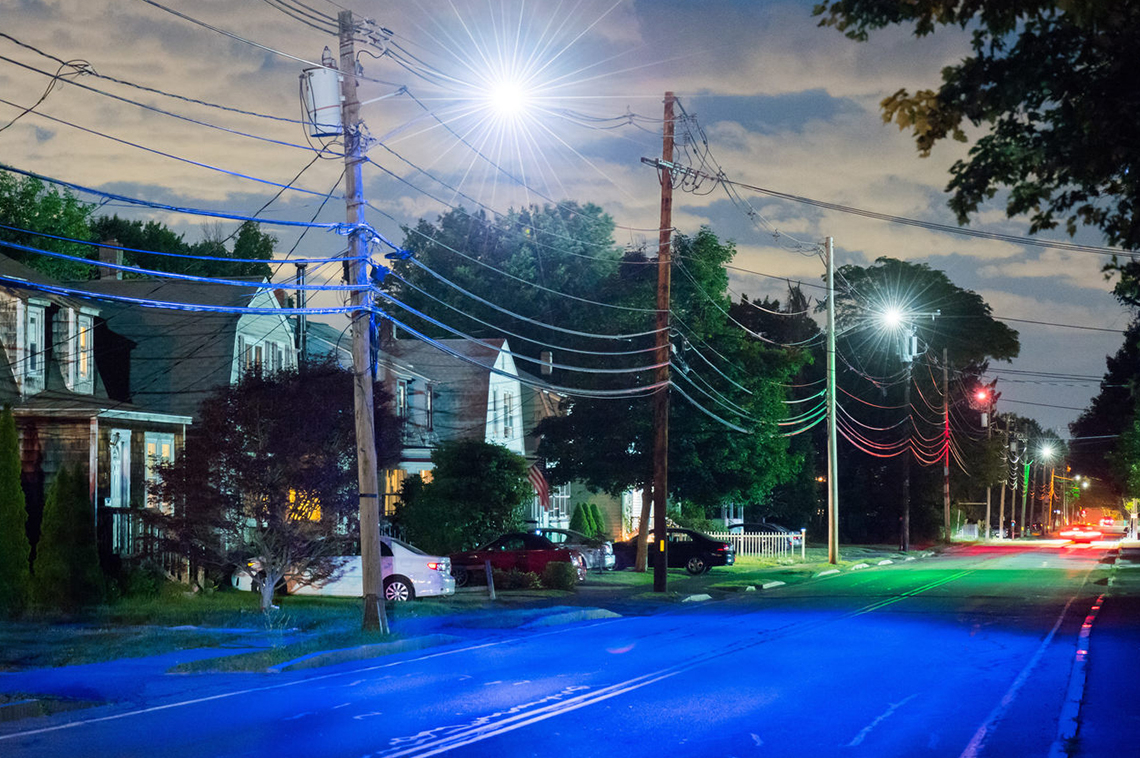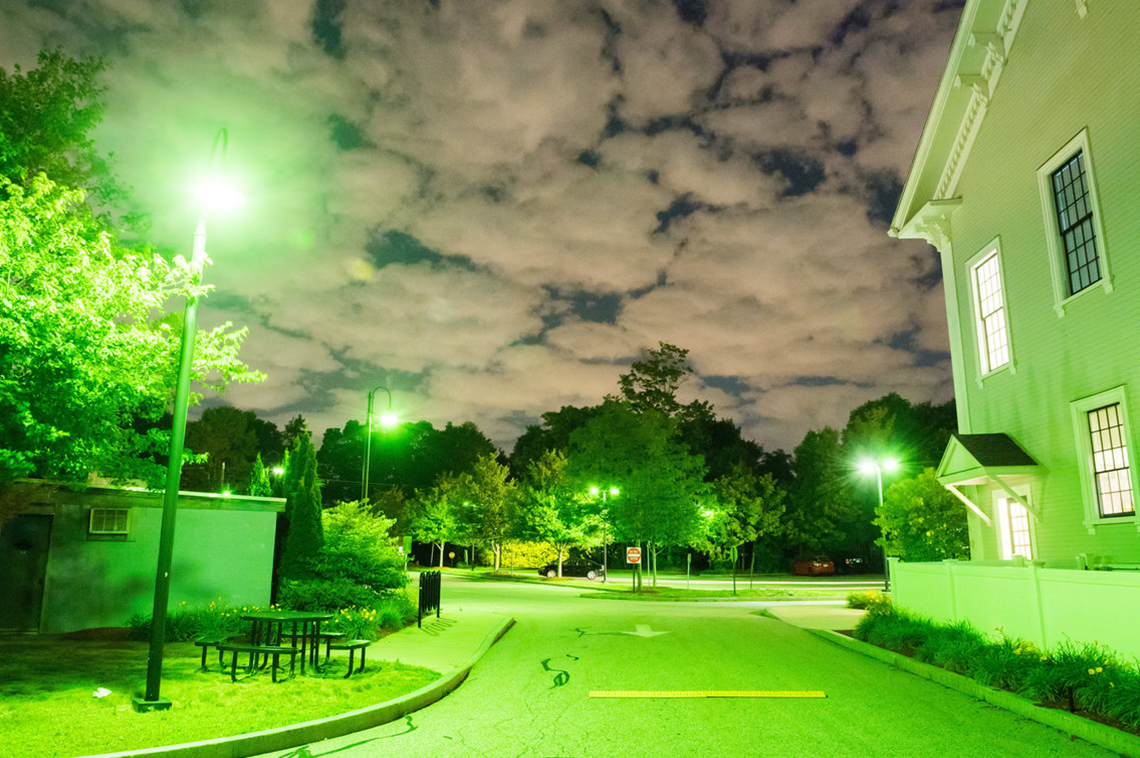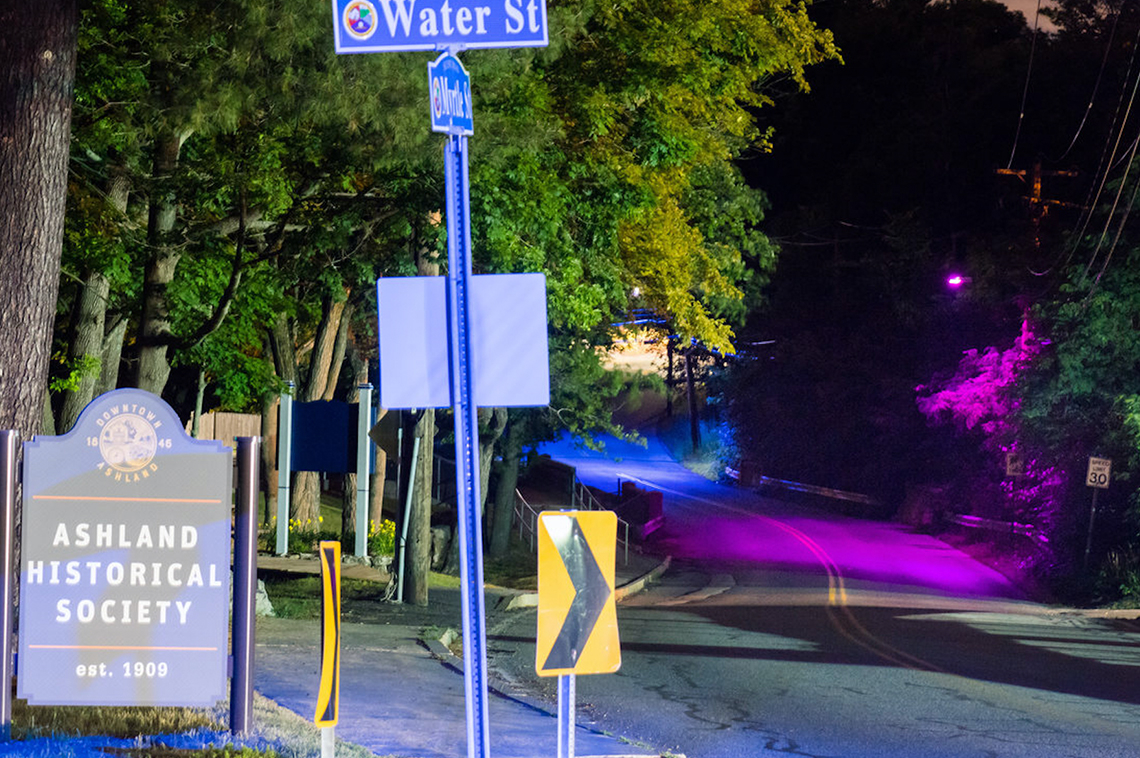


Most nights, the streetlights that illuminate Ashland, Massachusetts, are a uniform white. They shine down on typical small-town things: families getting dinner on Main Street, kids bicycling home from each other’s houses.
But for a month in the summer of 2016, nighttime Ashland looked a little different. The town hall and its parking lot were tinted in green. The area around the Historical Society was bathed in purple. Around twilight, a group of people wearing all white might have walked through, clutching blank maps and handfuls of crayons and following a man with a determined expression.
Their leader, local artist Dan Borelli, was born in Ashland in 1973. For the past eight years, he’s been using art to draw attention to one of his hometown’s hidden histories: the legacy of Nyanza Color & Chemical Co., a dye factory that once stood in the center of Ashland and dumped over 45,000 tons of chemical sludge into its land, air, and water.
Besides turning the streetlights rainbow, Borelli—who lost several childhood friends to a cancer cluster eventually connected with the toxic waste—has put together an exhibition about the plant, and built a stained-glass pavilion, both located within and aimed at the immediate community. He calls his work The Ashland-Nyanza Project.
When you grow up with a contaminated site in the background of your life, “you can’t shake it as you grow,” Borelli explains. “It shapes you.” He can’t shape it back: The area around the former factory is now a Superfund site, permanently capped by the government to prevent more toxins from escaping. But at least, he figures, he can color it.
"“Kids just a few years older than me played on that field. You’d hit a foul ball and you’d go to get it and you’d pull it out of a puddle and it was orange."
The first dye plant moved to the center of Ashland in 1917. Although the building changed hands a number of times, it produced textile dyes straight through until 1978, when its last occupant, Nyanza, went out of business. Although Borelli doesn’t have firsthand memories of the plant—he was five years old when it closed—local lore and his own research have painted a picture for him, full of color bleeding into places it didn’t belong.
A pink fog might roll over the town, and at least once, it snowed blue. Workers would come home from the plant and literally sweat out the day’s pigments. Young people had colorful encounters on running trails, or at the local T-ball field, which was right across the train tracks from the factory. “Kids just a few years older than me played on that field,” Borelli says. “You’d hit a foul ball and you’d go to get it and you’d pull it out of a puddle and it was orange.”
Those hues hid dozens of different harmful chemicals. In 1971, authorities found mercury in the nearby Sudbury river, and the state ordered Nyanza to stop illegally discharging waste. By the time Borelli was old enough to chase down foul balls, the town had moved the T-ball field. The EPA declared the former plant a Superfund site in 1982, one of the first in the country. Officials began the long process of containing the toxins, sloughing the contaminated sludge into a set area, and capping it with clay, plastic, and a top layer of grass and dirt. It now looks like an ordinary field.
But by the time the cap was completed in the early 1990s, some of the wastes’ effects had already soaked in. When Borelli was in his late teens and early 20s, at least five of his peers developed rare forms of cancer. One of them, Kevin Kane, spent the last years of his life talking to his neighbors and to public health officials, trying to figure out whether these concurrent diagnoses were truly a coincidence.
Kane died in 1998. In 2006, the Massachusetts Department of Public Health completed a study that bore out his suspicions. Although an earlier report had found no link between cancers reported in Ashland and the former site, this one concluded that “the relative risk of developing cancer was greater for study participants with some types of reported exposures in areas of the Nyanza Chemical Waste Dump.” In other words, children who had splashed in those multicolored puddles were over twice as likely to get sick.
Before he started this project, Borelli says, he’d always thought of color the way most artists do: as a tool for expression, and a fruitful site of philosophical inquiry. He hadn’t really thought about its role in his town’s history until about 2010, when he ran across information about Nyanza while doing research for his thesis at the Harvard Graduate School of Design. “I had never conceived of color as having a negative environmental impact,” he says. As he puts it in a talk he gives about this project, “I could no longer separate phenomenology from ecology, [or] color from carcinogen.”
He changed up his research, and decided to focus on Ashland. If he hadn’t known about this, he thought, how many others didn’t? After five years of digging through town archives, interviewing community members, and raising grant money, Borelli began rolling out his project in the fall of 2015. The first place he chose was the Ashland Town Library, which, thanks to the work of local activists during the 1980s, was already home to a cache of official documents detailing the plant’s history, diagnosis, and remediation. (The EPA now creates these “field repositories” at most Superfund sites.)
Borelli turned the library into a multimedia exhibit. Just above the shelves of EPA documents, a monitor screened video interviews with community members and government scientists. (In one, a member of the Massachusetts Department of Public Health describes interviewees who told her that as children, they used to lick the colorful icicles that hung off the factory building “like popsicles.”) Display cases inside the library held Nyanza memorabilia: advertisements; yarn samples; colorful swatches of cloth. Borelli installed a 3D-printed model of the Sudbury River, and arranged it so the water, which was made of mirrored glass, reflected the shifting colors of the two hand-dyed tapestries hung nearby.
As part of the exhibit, Borelli and the project’s intern, Ming Tu, also made an interactive map of the contaminated plume of groundwater that still sits beneath the town. Using data from 20 years of EPA reports, they figured out where certain chemicals had been found offsite even after the cap was complete. Just last year, the town began looking at legislation that would mandate the consideration of the plume in zoning decisions. Before that, Borelli says, barely anyone even knew about it. “There are predominantly renters in the plume, and it had never been communicated [to them],” he says. With the map, you can click it into visibility: choose a particular chemical, and a cloud of color suddenly appears, obscuring the area where that chemical has been found.
The digital map was effective. After the exhibition was removed at the end of 2015, it stayed in place, and it is now a permanent part of the library. But Borelli still found it a bit too abstract. If you can fit something on a screen, he says, you don’t always understand its true size. “Most people can’t read scale,” he says. He started thinking about the cartographic practice of ground-truthing: after you make a bird’s-eye view of someplace, you have to walk it, using your body to verify what your mind has measured.
" I had never conceived of color as having a negative environmental impact. I could no longer separate phenomenology from ecology, [or] color from carcinogen."
And so in June of 2016, Borelli teamed up with Ashland’s Department of Public Works and put colored gels on the town’s streetlights. The colors matched the collective concentration of chemicals in the groundwater plume, from red—denoting a high amount—to purple, for a low one. The gels stayed up for about a month, during which Borelli led twilight mapmaking tours for interested parties, starting in the green-tinted parking lot of the town hall. “I would give them a black and white map of Ashland, and then a box of eight different Crayola crayons,” he says. “And I’d say, alright, let’s go for a walk.”
He finally got the visceral reactions he had expected. “I don’t think people fully understood the depth and breadth of the contaminated groundwater plume until they walked it under the lights,” he says. “When they did that, they went, ‘Oh, boy.’” He says he even surprised himself, as well as fellow members of an activist group, the Ashland Citizens Action Committee (ACAC), that had formed a few months earlier in response to a proposed housing development near the Nyanza site. ACAC now incorporates Borelli’s materials into their messaging.
Borelli had used color to provoke understanding, curiosity, anger, and action. But he wanted to do something else with it, too. That same summer, he began working on the most recent piece of the project: a memorial space, which he calls the Ashland Healing Garden, located on town land just south of the Superfund site.
The garden’s centerpiece is a stained-glass pavilion. It has dozens of panes, tiled in the shape of an umbrella and arranged in rainbow order, like a color wheel. If someone is standing nearby when the sun hits the plexiglass, they’re immediately spangled by red, orange, blue, or purple. But they don’t have to worry about these strange hues, or wash them off. As Borelli says, the pavilion was designed to be a place where “people could go and experience color, but in a healing way.”
The garden has been the most successful communal effort yet. While Borelli was researching the land it stands on, he found out that it used to belong to the Nipmuc people. When it came time to dedicate the pavilion late last summer, he invited a Nipmuc healer to perform a ceremony, alongside Kevin Kane’s mother. Families take their kids to hang out under the pavilion. All of the construction is being done by students from the nearby New England Laborers Training Academy, who are clearing land and building paths there as part of their safety training. “They’re taking it to a level of completion that’s far beyond what I originally envisioned,” says Borelli.
But it has also been a flashpoint for pushback. Late last summer, vandals broke every pane of glass in the pavilion. Some residents have accused Borelli of trying to drive property prices down. Borelli is distressed by these reactions, which he sees as an unwillingness to learn about or from the past. “Since when did not knowing become the best option?” he says. “When I’m feeling like a real smartass, I’ll say, ‘You can take the ostrich approach in life, but you definitely shouldn’t bury your head in the sand in Ashland.’”
Last summer, Borelli thought the project was coming to a close. But the vandalism, combined with the current EPA’s deregulation-oriented strategy, “has reinvigorated me,” he says. He’s now raising funds to rebuild the pavilion, and he may even try to get the Nyanza site designated as a historic landmark. He thinks of it as a ruin, he says. “In much the same way that the Forum signifies the failure of the Roman Empire, this landform… signifies a ruin of a particular political moment, when industry was unregulated.” If the poison might always be there, at least something else will be, too.
This piece originally appeared in Atlas Obscura on February 15, 2018.
To learn more about Dan Borelli's ArtPlace Project visit: ILLUMINATING FUTURES





